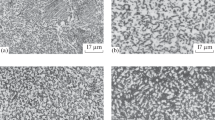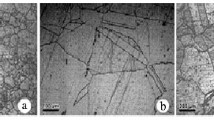Abstract
The kinetics of hydrogen-induced cracking have been studied in the Ti-5Al-2.5Sn titanium alloy having a structure of acicular α platelets in a β matrix. It was observed that the relationship between hydrogen-induced crack growth rate and applied stress intensity can be described by three separable regions of behavior. The crack-growth rate at low stress-intensity levels was found to be exponentially dependent on stress intensity but essentially independent of temperature. The crack-growth rate at intermediate stress-intensity levels was found to be independent of stress intensity but dependent on temperature in such a way that crack-growth rate was controlled by a thermally activated mechanism having an activation energy of 5500 cal per mole and varied as the square root of the hydrogen pressure. The crack-growth rate at stress-intensity levels very near the fracture toughness is presumed to be independent of environment. The results are interpreted to suggest that crack growth at high stress intensities is controlled by normal, bulk failure mechanisms such as void coalescence and the like. At intermediate stress-intensity levels the transport of hydrogen to some interaction site along the α-β boundary is the rate-controlling mechanism. The crack-growth behavior at low stress intensities suggests that the hydrogen interacts at this site to produce a strain-induced hydride which, in turn, induces crack growth by restricting plastic flow at the crack tip.
Similar content being viewed by others
References
H. G. Nelson, D. P. Williams, and J. E. Stein:Met. Trans., 1972, vol. 3, pp. 469–75.
H. G. Nelson:Environmental Hydrogen Embrittlement of Titanium-A Qualitative Comparison with Stress-Corrosion Cracking, Proc. of Int. Conf. on Stress Corrosion Cracking Mechanisms in Titanium Alloys, Atlanta, Georgia, 1971, in press.
G. T. Pittinato:Trans. ASM, 1969, vol. 62, pp. 410–17.
W. D. Bixier:Flaw Growth of Inconel 718 and SAl-2.5Sn (ELl)Titanium in a High Purity Gaseous Hydrogen Environment, Aerojet Nuclear Systems Co., NERVA Programs, Contract SNP-1, Aug. 1970.
C. M. Carman and D. E. Schillinger:ASME Publ. 70-MET-4, 1970.
S. Mostovoy, P. B. Crosley, and E. I. Ripling:J. Mater., 1967, vol. 2, no. 3, pp. 661–81.
T. R. Beck, M. J. Blackburn, and M. 0. Speidel: Contract NAS7489, Quarterly Progress Rept. No. 11, Boeing Company, March 1967.
W. F. Brown:Amer. Soc. Test. Mater, Special Tech. Publ. No. 463, 1970.
C. F. Tiffany, P. M. Lorenz, and L. R. Hall:NASA CR-54837, February, 1966.
S. M. Wiederhorn:Int. J. Fract. Mech., 1968, vol. 4, no. 2, pp. 171–77.
C. S. Carter: DG-25274, The Boeing Company, May 1970.
R. P. Wei and J. P. Landes:Mater. Res. Stand., 1969, vol. 9, pp. 25–29.
J. D. Boyd, P. J. Moreland, W. K. Boyd, R. A. Wood, D. N. Williams, and R. I. Jaffee:NASA CR-1846, October 1971.
C. S. Carter:Eng. Fract. Mech., 1971, vol. 3, no. 1, pp. 1–13.
S. Mostovoy, H. R. Smith, R. G. Lingwall, and E. J. Ripling:Eng. Fract. Mech, 1971, vol. 3, no. 3, pp. 291–99.
A. B. J. Clark and G. R. Irwin:Exp. Mech. SESA, 1966, vol. 6, pp. 321–39.
D.P. Williams and H.G. Nelson:Met. Trans., 1970, vol. 1, pp. 63–68.
H. G. Nelson, D. P. Williams, and A. S. Tetelman:Met. Trans., 1971, vol. 2, pp. 953–59.
J. H. De Boer:The Dynamical Character of Adsorption, Oxford, London, 1953.
W. R. Holman, R. W. Crawford, and F. Paredes:Trans. TMS-AIME, 1965, vol. 233, pp. 1836–39.
R. J. Wasilewski and G. L. Kehl:Metallurgia, 1954, vol. 50, pp. 225–30.
J. D. Boyd:Trans. ASM, 1969, vol. 62, pp. 977–88.
E. L. Owen, F. H. Beck, and M. G. Fontana: Contract NGL-36-008-051, Semiannual Rept., Ohio State University, Dec. 1970.
R. P. Allen, R. Taggart, and D. H. Polonis:Acta Met., 1966, vol. 14, pp. 741–47.
R. S. Vitt:Hydride Precipitationim Titanium, Ph.D. Thesis in Engineering, UCLA, 1969.
A. H. Cottrell:Theoretical Structural Metallurgy, St. Martins Press Inc., New York, 1960.
G. R. Irwin and J. A. Kies:Welding Research Supplement, 1954, pp. 1935–85.
R. G. Hoagland:Trans. ASME, Ser. D-J. Basic Eng., 1967, vol. 89, pp. 525–32.
C. N. Freed and J. M. Krafft:J. Mater., 1966, vol. 1, no. 4, pp. 740–90.
Author information
Authors and Affiliations
Rights and permissions
About this article
Cite this article
Williams, D.P., Nelson, H.G. Gaseous hydrogen-induced cracking of Ti-5Al-2.5Sn. Metall Trans 3, 2107–2113 (1972). https://doi.org/10.1007/BF02643219
Received:
Issue Date:
DOI: https://doi.org/10.1007/BF02643219




